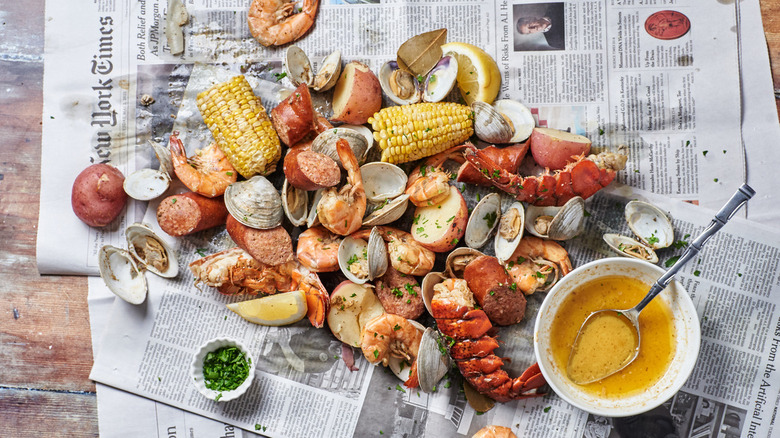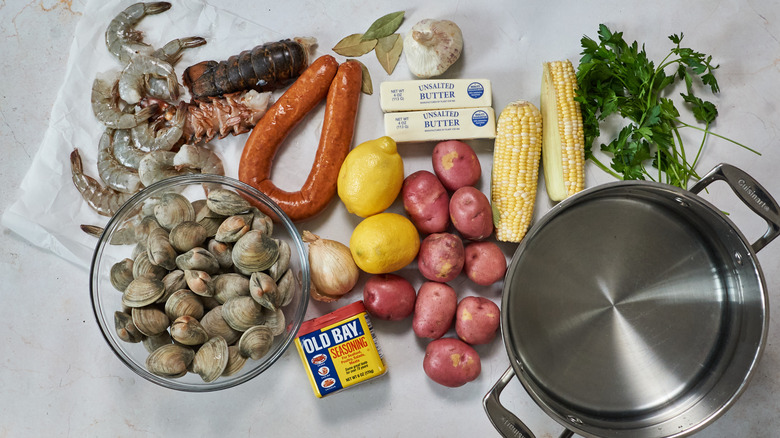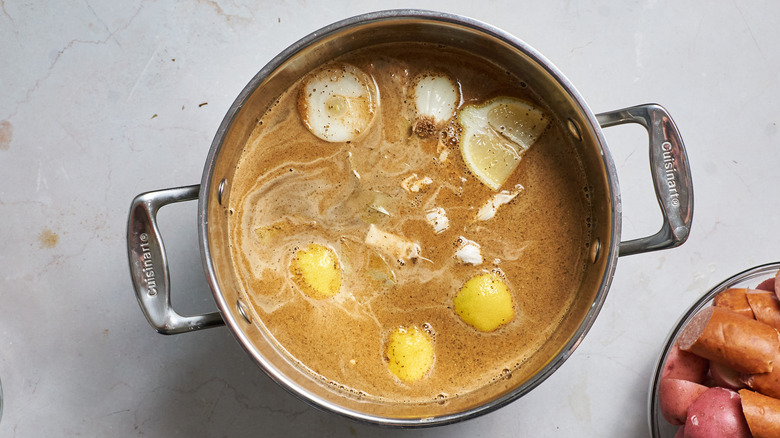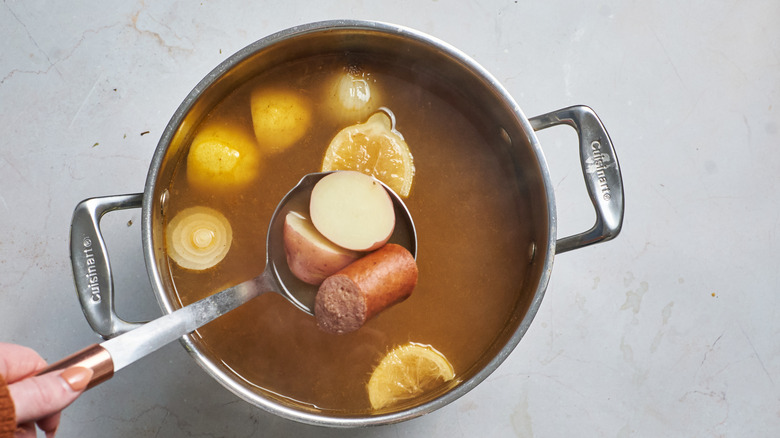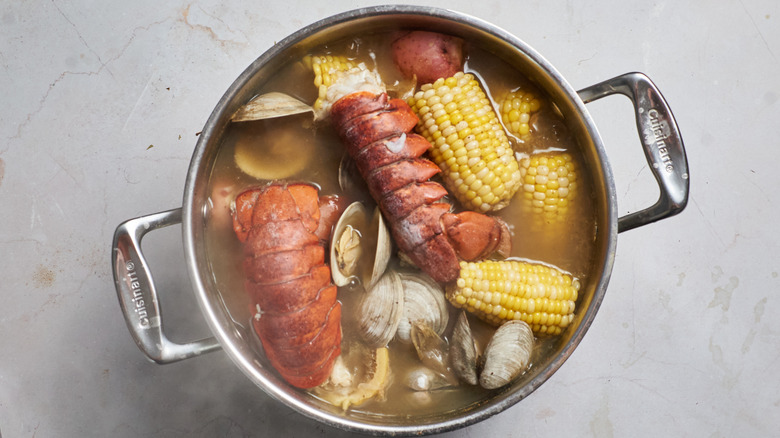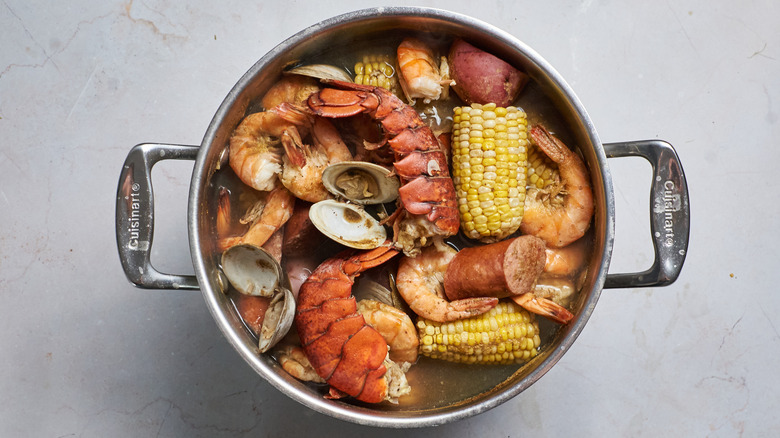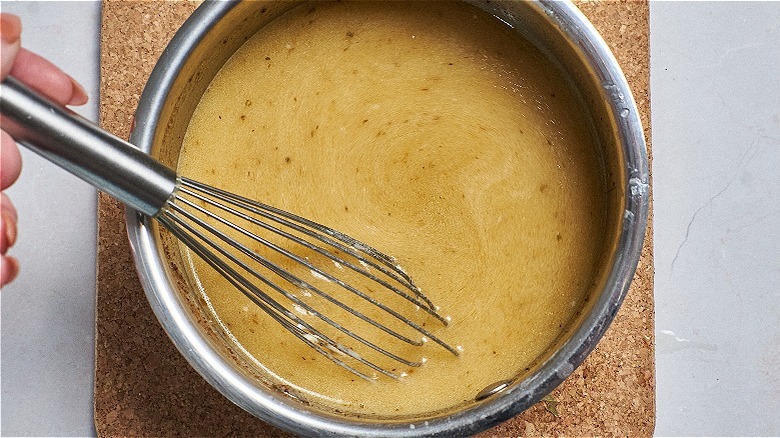Festive Seafood Boil Recipe
Seafood boils are popular along the coastal eastern states all the way from Canada down to Louisiana. Each region has a slightly different way of cooking, boiling, steaming, or baking the seafood, and each includes a fish or two special to their waters. In each iteration, though, the idea is the same: a steaming pile of seasoned seafood made to share with friends and family.
In Louisiana, the seafood boils include crawfish, a bright-red prawn local to the state. In northern states like Maryland, the seafood boils showcase crabs, a delicacy of the Chesapeake Bay. Even farther north, a seafood boil might involve clams and mussels, baked in the sand rather than boiled; and a little ways south they'll add in potatoes, corn, and sausage to a similar mix of boiled crustaceans. This recipe shared by Michelle McGlinn takes inspiration from the New England bakes and boils and combines it with the Lowcountry sausage and potato style. Potatoes, corn, clams, lobster, shrimp, and sausage are boiled in a deeply rich broth of onion, garlic, and Old Bay until tender, then coated in seasoned butter to enjoy plate-free. Don't be afraid to get your hands dirty with this one: the best way to eat it is around a paper-covered table crowded with friends.
Grab all the ingredients for a festive seafood boil
For the seafood boil, you'll first make a broth of water, onion, garlic, lemon, bay leaves, and Old Bay. You'll need a lot of Old Bay for this recipe, so look for the bigger size at the store, enough to fill at least a half cup. Once you have the broth boiling, you'll drop in potatoes — we recommend red potatoes, which hold their shape in such a hardy recipe, but you can also swap for creamier Yukon golds. Next, grab Andouille or Kielbasa sausage, shucked corn, a bag of clams, a couple of lobster tails, and a pound of shrimp. You can switch up the seafood based on where you live and what's in season, like using mussels instead of clams or crabs instead of lobsters.
For the buttery sauce that finishes the dish, you'll need two sticks of butter, more garlic, more lemon, and more Old Bay. Then, you'll just need parsley to sprinkle over everything.
Bring the broth to a boil
If you've ever made vegetable stock before, you'll recognize this step. While the water heats up, drop in the onion (skin on, if clean), garlic (skin on, here, too), bay leaves, lemon, and Old Bay seasoning. The water will darken to a deep reddish-brown thanks to the seasonings in Old Bay, and before long you'll smell the fragrance of the onion and garlic, too. If desired, you can drop in any vegetable scraps you have on hand, such as celery, fennel, scallions, or carrot tops; just make sure they're clean, since we're cooking the seafood directly in the broth.
Boil the potatoes first
The potatoes and sausage take the longest time to cook and can withstand a few extra minutes in the boil; unlike shrimp that gets rubbery after just a short few minutes. Drop the potatoes and sausage in first and boil until the potatoes are tender enough to be sliced easily with a knife or poked through with a fork. You don't need them to be super-tender yet, since they'll continue to cook with the seafood, so keep the boil around 10 minutes.
Boiling the seafood
This recipe is near-foolproof because of how discernable cooked seafood is. The only thing to remember? Shrimp goes last, because it cooks faster than anything else in the pot. Drop in the corn, clams, and lobster, and cover the lid to allow steam to cook the fish on top. While clams cook slightly faster than lobster, we recommend adding the clams first so the lobster stays at the top of the pot. You might also realize the value of those giant, stainless-steel stockpots so ubiquitous with boils: If the water starts boiling over the top after adding the clams, use a measuring cup to remove a cup or two of broth. Then, boil away until the clams open and the lobster turns bright red.
Finishing the boil
A few minutes before you're ready to remove the boil from the heat, drop in the shrimp, peel and tails on. Keep an eye on the shrimp, and as soon as they become opaque with a pinkish hue, remove the pot from the heat. This will only take about 2 minutes, so don't walk away from the boil.
Reserve a ½ cup of broth, then strain the boil over a large colander. If you don't have a large enough colander, work in batches, offloading the drained seafood onto a newspaper-prepped table (or large serving dish, if you have one big enough to handle the boil). Sprinkle the seafood with parsley.
Making the Old Bay sauce
While you can enjoy a seafood boil without copious amounts of butter, a good buttery sauce will make the dish completely irresistible. This one is warm, flavorful, and rich, and adds a layer of golden, garlicky depth to the boiled seafood. Heat the butter in the microwave or a small saucepan until melted, then whisk in the reserved broth, grated garlic, lemon juice, and additional Old Bay. You can taste the sauce to make sure it's seasoned to your liking, but you might find yourself inhaling spoonfuls before you even get to the seafood. Don't say we didn't warn you.
Serving a seafood boil
Like we mentioned before, seafood boils are best served on a covered surface where the corn, clams, shrimp, and sausage are all visible and available to anyone at the table. It's common in northern seafood boils to use brown paper or newspaper, both readily available in most households and fairly butter-resistant. In the South, it might be more common to use a tablecloth to shield the table below from colorful seasonings. If serving table-style isn't your thing, just serve in large bowls, batching as needed. We know — sometimes risking butter on the table just isn't worth the hassle (but the kids sure will love it).
Seafood boils have everything you need for a full meal and then some – protein, veggies, meat, and carbs. If you're still looking for a side dish to pair this with, we recommend grilled vegetables like broccolini or summer squash. Better yet, pair it with a cold beer and a few batches of Lynchburg lemonades, and you've got yourself a perfect summer soirée.
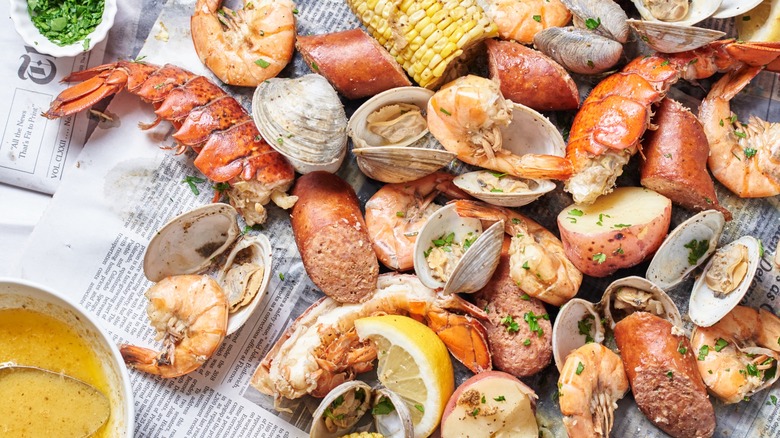
- 16 cups water
- 1 medium onion, washed, halved
- 5 garlic cloves, smashed
- 2 lemons, divided
- 5 bay leaves
- 1 tablespoon + ½ cup Old Bay seasoning
- 2 pounds red potatoes (about 12 potatoes), halved
- 1 pound Andouille sausage, sliced into 3-inch pieces
- 3 ears of corn, halved
- 50 littleneck clams
- 2 lobster tails
- 1 pound jumbo shrimp (16-20 count)
- ¼ cup parsley, for serving
- ½ cup butter (2 sticks), melted
- Juice from ½ lemon
- 1 garlic clove, grated
- Heat water in a large stockpot over medium heat. Add the onion, garlic, bay leaves, Old Bay, and 1 lemon sliced in half and bring to a boil.
- Add the halved potatoes and sausage and boil until potatoes are tender, about 10 to 15 minutes.
- Once potatoes are tender, add the corn and clams. Making room in the broth, nestle in the lobster tails and cover the pot. Cook until clams have opened and lobster tails are bright red, about to 10 minutes.
- Add the shrimp and cook until shrimp is pink, about 3 minutes. Reserve ½ cup of broth, then drain.
- To make the Old Bay sauce, mix together the melted butter and reserved broth until smooth. Add the lemon juice, garlic, and Old Bay seasoning and stir until well combined.
- To serve, spoon the Old Bay sauce over the seafood boil, and serve any remaining sauce alongside the seafood. Cut the remaining lemon into wedges and serve the boil with lemon and parsley.
